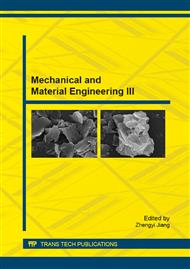p.205
p.212
p.218
p.225
p.229
p.235
p.240
p.245
p.259
Simulated Annealing Applied to Optimize the Efficiency of Flexible Manufacturing Cells
Abstract:
This work proposes a new methodology to optimize flexible manufacturing cells applying Simulated Annealing and Contribution Margin concepts. This methodology helps to determine the number of extra products that could be sold and manufactured while taking advantage of this idleness. The price formation to sell the extra products was based on contribution margin concepts. The main concept is to use cell idleness to increase profits while the costs are already paid. Equipment and workers have their fixed costs paid regardless of whether they are active or not. When they are not active, all of their costs are considered to be losses. What motivated the present work was the fact that, in general, the idleness detected in manufacturing processes does not receive adequate attention in the sense of taking advantage of it. To achieve this purpose, a program was developed to implement the methodology. This program generates user interfaces that allow the prediction of daily scheduling parts production. The first interface identifies only bottlenecks and idleness. The second interface, based on the Simulated Annealing (SA) metaheuristic technique, was designed to perform the management of idleness. A database was organized to present current and future daily scheduling parts production. Based on the volume of sales and the lead time of sold products, sellers are always able to update this database. Thus, the program can provide through its user interface, at any time, all of the information about production data for a specific schedule day that comes from the database. The user mentioned here is expected to be an industry salesman. Thus, it will always be possible to have previous knowledge about the bottlenecks and idleness that exist for any scheduled day in the future. This knowledge allows for planning the process of selling extra products made from the existing idleness. Two aspects were considered with respect to selling extra products that are produced via taking advantage of the idleness: the delivery time and the contribution margin of each product. To validate the program, a simulation was performed to determine which products should be produced during a scheduled day to ensure the delivery times or to ensure the maximum contribution margin, while considering the delivery time that is available. As a final consideration, the software can be considered to be functional and responsive to the possibility of profit maximization from the use of cell idleness.
Info:
Periodical:
Pages:
245-258
Citation:
Online since:
July 2015
Keywords:
Price:
Сopyright:
© 2015 Trans Tech Publications Ltd. All Rights Reserved
Share:
Citation:


